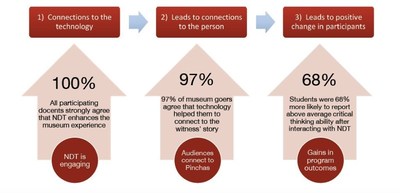LOS ANGELES, June 21, 2016 -- Initial evaluations from the pilot exhibition of USC Shoah Foundation's New Dimensions in Testimony – a groundbreaking project that enables audiences to have a "virtual conversation" with projected images of Holocaust survivors – is proving the new technology is a valuable tool to ensure future generations will be able to have personal interactive experiences with Holocaust survivors long into the future.
Middle and high school students who engage with 83-year-old Buchenwald survivor Pinchas Gutter, the project's first of 12 subjects, experience a learning environment in which he answers questions as if he was in the room with them. The technology uses new and emerging filming and display technologies, coupled with advanced natural language processing, to create the perception Pinchas is responding to questions conversationally with answers that are authentic and spontaneous.
USC Shoah Foundation has long recognized the value for students to meet and talk to Holocaust survivors. Hearing about one of the most important events in history directly from someone who lived through it provides a framework for students to debate the many issues impacting their own lives today – bullying, hatred, discrimination, refugees and immigration.
"We have strived to make this project as future-proof as possible," said Stephen Smith, executive director of USC Shoah Foundation. "It's not linked to a platform, or a particular software or a particular gadget. It's going to emerge through all sorts of different ways as technology develops. What it means is, whether in a museum, or in an institution of learning, or at home, you're going to be able to interact with Holocaust survivors for generations to come."
The Illinois Holocaust Museum and Education Center (IHME) was the first museum to pilot New Dimensions in Testimony in April 2015 with docent-led interactions. The evaluation of audiences from The Illinois Holocaust Museum and Education Center is showing that interaction with the New Dimensions in Testimony exhibit helps students develop empathy. Museum visitors also mentioned learning about the importance of tolerance, respect, and compassion. These gains were even stronger in the student pilots, where students listened to a survivor in person and/or interacted with the New Dimensions in Testimony exhibit. While both experiences were strongly positive, the students interacting with the New Dimensions in Testimony exhibit had even greater gains.
Key findings from that pilot indicate:
- New Dimensions in Testimony is engaging and meaningful to museum audiences and students.
- Student gains were reported in interest in historical topics, critical thinking, and knowledge of issues going on in the world.
- Audiences connect with the New Dimensions in Testimony exhibit, valuing the witness' story and the technology.
- Interactions with the New Dimensions in Testimony exhibit help audiences to realize positive outcomes that are consistent with the USC Shoah Foundation's Theory of Change that asserts by engaging with testimonies, people gain understanding and skills that motivate and inspire them to be more responsible citizens in society.
New Dimensions in Testimony is now being piloted at United States Holocaust Memorial Museum in its Wexner Center through August 2016. In this setting audiences are asking questions directly to Pinchas.
Pinchas, who smiles back at them from an 80-inch screen, is always ready for questions.
"Were you allowed to play with other kids?"
"Did you have any siblings?"
"Did you want revenge?"
Pinchas – or rather his prerecorded likeness – answers their questions with eloquence, wisdom and kindness.
"I have found people are less afraid to ask Pinchas questions, because they are not worried they will offend him, which allows for deeper questions to be asked," observed an Illinois Holocaust Museum and Education Center museum docent.
Illinois Holocaust Museum and Education Center audiences of all ages were moved by the exhibit. Nearly 100 percent of the 229 visitors surveyed said the technology enhanced their ability to connect with the story of the survivor. And nearly 100 percent said the experience will leave a lasting effect.
Envisaged by concept developer Conscience Display, New Dimensions in Testimony was realized with technological guidance from USC's world-renowned Institute for Creative Technologies.
"It's been clear for some time that New Dimensions in Testimony is a technological breakthrough without precedent," said Smith. "The newly released survey indicates that New Dimensions in Testimony also has potential to be an educational breakthrough."
About USC Shoah Foundation
USC Shoah Foundation — The Institute for Visual History and Education is dedicated to making audio- visual interviews with survivors and other witnesses of the Holocaust and other genocides, a compelling voice for education and action. The Institute's current collection of more than 53,000 eyewitness testimonies contained within its Visual History Archive® preserves history as told by the people who lived it, and lived through it. Housed at the University of Southern California, within the Dana and David Dornsife College of Letters, Arts and Sciences, the Institute works with partners around the world to advance scholarship and research, to provide resources and online tools for educators, and to disseminate the testimonies for educational purposes.
Visual History Archive® is a registered trademark of USC Shoah Foundation – The Institute for Visual History and Education Reg. U.S. Pat & Tm. Off.
Contact: Josh Grossberg 213-740-6065
[email protected]
Rob Kuznia 213-740-0965
[email protected]
